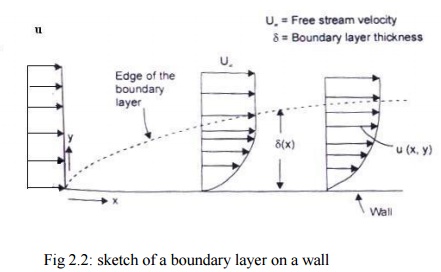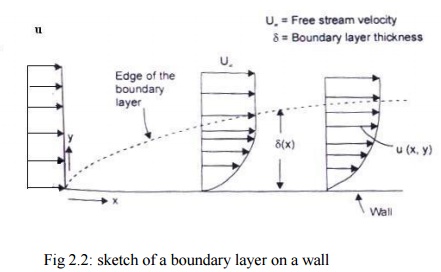Chapter:
Thermal and Hydrodynamic Boundary Layer

Formation of a Boundary Layer
When
a fluid flow, over a surface, irrespective of whether the flow is laminar or
turbulent, the fluid particles adjacent to the solid surface will always stick
to it and their velocity at the solid surface will be zero, because of the
viscosity of the fluid. Due to the shearing action of one fluid layer over the
adjacent layer moving at the faster rate, there would be a velocity gradient in
a direction normal to the flow.

Let us consider a
two-dimensional flow of a real fluid about a solid (slender in cross-section)
as shown in Fig. 2.2. Detailed investigations have revealed that the velocity
of the fluid particles at the surface of the solid is zero. The transition from
zero velocity at the surface of the solid to the free stream velocity at some
distance away from the solid surface in the V-direction (normal to the
direction of flow) takes place in a very thin layer called 'momentum or
hydrodynamic boundary layer'. The flow field can thus be divided in two
regions:
( i) A very thin layer
in t he vicinity 0 f t he body w here a velocity gradient normal to the
direction of flow exists, the velocity gradient du/dy being large. In this thin
region, even a very small Viscosity mof
the fluid exerts a substantial Influence and the shearing stress t = m du/dy may assume large values. The thickness of the
boundary layer is very small and decreases with decreasing viscosity.
(ii) In the remaining
region, no such large velocity gradients exist and the Influence of viscosity
is unimportant. The flow can be considered frictionless and potential.
Thermal Boundary Layer
Since
the heat transfer by convection involves the motion of fluid particles, we must
superimpose the temperature field on the physical motion of fluid and the two
fields are bound to interact. It is intuitively evident that the temperature
distribution around a hot body in a fluid stream will often have the same
character as the velocity distribution in the boundary layer flow. When a
heated solid body IS placed In a fluid stream, the temperature of the fluid
stream will also vary within a thin layer In the immediate neighbourhood of the
solid body. The variation in temperature of the fluid stream also takes place
in a thin layer in the neighbourhood of the body and is termed 'thermal
boundary layer'. Fig. shows the temperature profiles inside a thermal boundary
layer.

Hydrodynamic
Boundary Layer :
One of the most
important concepts in understanding the external flows is the boundary layer
development. For simplicity, we are going to analyze a boundary layer flow over
a flat plate with no curvature and no external pressure variation.
Ø Boundary
layer thickness (d): defined as the distance away from the surface where the
local velocity reaches to 99% of the free-stream velocity, that is u(y=d)=0.99U¥.
Somewhat an easy to understand but arbitrary
definition.
Ø Boundary
layer is usually very thin: d/x
usually << 1.
Ø As
we have seen earlier,the hydrodynamic boundary layer is a region of a fluid
flow, near a solid surface, where the flow patterns are directly influenced by
viscous drag from the
surface wall.
Ø 0<u<U, 0<y<d
Ø The
Thermal Boundary Layer is a region of a fluid flow, near a solid surface, where
the fluid temperatures are directly influenced by heating or cooling from the
surface wall.
Ø 0<t<T, 0<y<dt
Ø The
two boundary layers may be expected to have similar characteristics but do not
normally coincide. Liquid metals tend to conduct heat from
the wall easily and
temperature changes are observed well outside the
dynamic boundary layer. Other materials tend to show velocity changes well
outside the thermal layer.